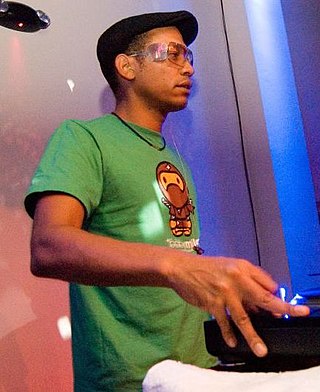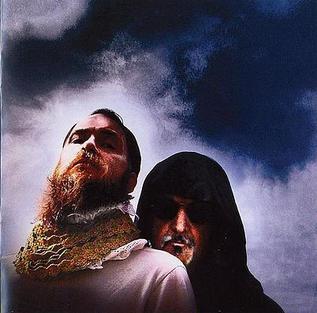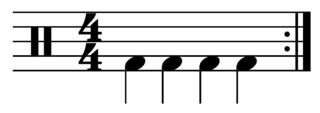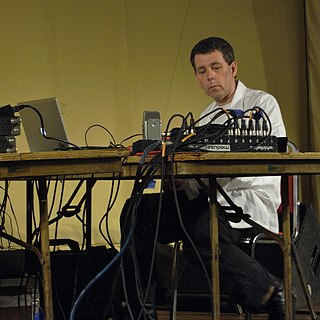Electronic music broadly is a group of music genres that employ electronic musical instruments, circuitry-based music technology and software, or general-purpose electronics in its creation. It includes both music made using electronic and electromechanical means. Pure electronic instruments depended entirely on circuitry-based sound generation, for instance using devices such as an electronic oscillator, theremin, or synthesizer. Electromechanical instruments can have mechanical parts such as strings, hammers, and electric elements including magnetic pickups, power amplifiers and loudspeakers. Such electromechanical devices include the telharmonium, Hammond organ, electric piano and electric guitar.

Daniel Andrew Williamson, better known as LTJ Bukem, is a British drum and bass musician, producer and DJ. He and his record label Good Looking are most associated with the jazzy, atmospheric side of drum and bass music.
Noise music is a genre of music that is characterised by the expressive use of noise. This type of music tends to challenge the distinction that is made in conventional musical practices between musical and non-musical sound. Noise music includes a wide range of musical styles and sound-based creative practices that feature noise as a primary aspect.
Industrial music is a genre of music that draws on harsh, mechanical, transgressive, or provocative sounds and themes. AllMusic defines industrial music as the "most abrasive and aggressive fusion of rock and electronic music" that was "initially a blend of avant-garde electronics experiments and punk provocation." The term was coined in the mid-1970s with the founding of Industrial Records by members of Throbbing Gristle and Monte Cazazza. While the genre name originated with Throbbing Gristle's emergence in the United Kingdom, artists and labels vital to the genre also emerged in the United States and other countries.

Throbbing Gristle were an English music and visual arts group formed in Kingston upon Hull by Genesis P-Orridge and Cosey Fanni Tutti, later joined by Peter "Sleazy" Christopherson and Chris Carter. They are widely regarded as pioneers of industrial music. Evolving from the experimental performance art group COUM Transmissions, Throbbing Gristle made their public debut in October 1976 in the COUM exhibition Prostitution, and released their debut single "United/Zyklon B Zombie" and debut album The Second Annual Report the following year. P-Orridge's lyrics mainly revolved around mysticism, extremist political ideologies, sexuality, dark or underground aspects of society, and idiosyncratic manipulation of language inspired by the techniques of William S. Burroughs.

Autobahn is the fourth studio album by German electronic music band Kraftwerk, released in November 1974 by Philips Records. The album marked several personnel changes in the band, which was initially a duo consisting of Florian Schneider and Ralf Hütter; later, the group added Klaus Röder on guitar and flute, and Wolfgang Flür on percussion. The album also completed the group's transition from the experimental krautrock style of their earlier work to an electronic pop sound consisting mostly of synthesizers and drum machines. Recording started at the group's own Kling Klang facility, but was predominantly made at Conny Plank's studio. Autobahn also includes lyrics and a new look for the group that was suggested by Emil Schult, an associate of Schneider and Hütter.

Coil were an English experimental music group formed in 1982 in London and dissolved in 2005. Initially envisioned as a solo project by musician John Balance, Coil evolved into a full-time project with the addition of his partner and Psychic TV bandmate Peter Christopherson. Coil's work explored themes related to the occult, sexuality, alchemy, and drugs while influencing genres such as gothic rock, neofolk and dark ambient. AllMusic called the group "one of the most beloved, mythologized groups to emerge from the British post-industrial scene."

A sampler is an electronic musical instrument that records and plays back samples. Samples may comprise elements such as rhythm, melody, speech, sound effects or longer portions of music.
Hi-NRG is a genre of uptempo disco or electronic dance music (EDM) that originated during the late 1970s and early 1980s.
Electronic Music Studios (EMS) is a synthesizer company formed in Putney, London in 1969 by Peter Zinovieff, Tristram Cary and David Cockerell. It is now based in Ladock, Cornwall.

Four-on-the-floor is a rhythm used primarily in dance genres such as disco and electronic dance music. It is a steady, uniformly accented beat in 4
4 time in which the bass drum is hit on every beat . This was popularized in the disco music of the 1970s and the term four-on-the-floor was widely used in that era, since the beat was played with the pedal-operated, drum-kit bass drum.

Chris Carter is an English musician, best known for being a member of Throbbing Gristle and the duo Chris & Cosey, both with his longtime partner Cosey Fanni Tutti.

Modulations: Cinema for the Ear is 1998 documentary film on the history of electronic music, consisting of a documentary film, accompanied by a soundtrack album, and a 2000 book Modulations A History of Electronic Music by Peter Shapiro. The project was directed by Iara Lee, the maker of the documentary film Synthetic Pleasures.
Peter Shapiro is an American lawyer and music journalist. He wrote several reference works on music genres including Disco and Hip-hop, before moving into practice focusing on media law.

A synthesizer is an electronic musical instrument that generates audio signals. Synthesizers typically create sounds by generating waveforms through methods including subtractive synthesis, additive synthesis and frequency modulation synthesis. These sounds may be altered by components such as filters, which cut or boost frequencies; envelopes, which control articulation, or how notes begin and end; and low-frequency oscillators, which modulate parameters such as pitch, volume, or filter characteristics affecting timbre. Synthesizers are typically played with keyboards or controlled by sequencers, software or other instruments, and may be synchronized to other equipment via MIDI.
Daniel Otto Joachim Miller is a British music producer and founder of Mute Records.
Modulation is the process of varying one or more properties of a high-frequency periodic waveform.
Live electronic music is a form of music that can include traditional electronic sound-generating devices, modified electric musical instruments, hacked sound generating technologies, and computers. Initially the practice developed in reaction to sound-based composition for fixed media such as musique concrète, electronic music and early computer music. Musical improvisation often plays a large role in the performance of this music. The timbres of various sounds may be transformed extensively using devices such as amplifiers, filters, ring modulators and other forms of circuitry. Real-time generation and manipulation of audio using live coding is now commonplace.

Acid house is a subgenre of house music developed around the mid-1980s by DJs from Chicago. The style is defined primarily by the squelching sounds and basslines of the Roland TB-303 electronic bass synthesizer-sequencer, an innovation attributed to Chicago artists Phuture and Sleezy D circa 1986.

Boogie is a rhythm and blues genre of electronic dance music with close ties to the post-disco style, that first emerged in the United States during the late 1970s to mid-1980s. The sound of boogie is defined by bridging acoustic and electronic musical instruments with emphasis on vocals and miscellaneous effects. It later evolved into electro and house music.











